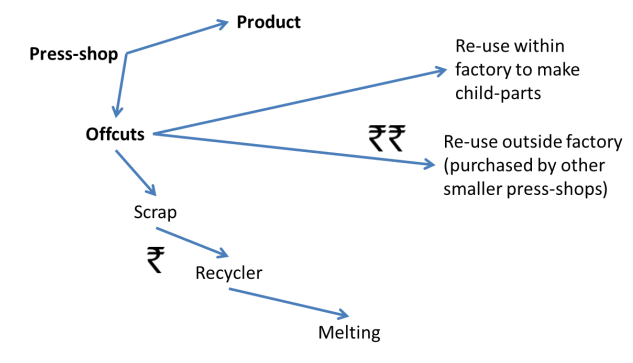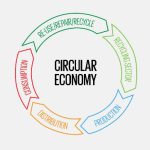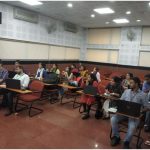More than the “stick”, the “carrot” needs to be presented to the common man to create awareness and consciousness about the state of the environment. This would serve as a motivation to undertake environmentally friendly initiatives. Having hosted various workshops for factory owners and personnel, the need for waste minimization through resource efficiency is emphasized. The more frugal we are with resource utilization, the lesser would be the waste generation. This eventually reduces the stress on downstream activities like segregation and recycling.
Most factories seek the end-of-pipe approach; “How much waste have we produced?” “What can be done with this waste?” As consultants, we focus on important questions upstream; “How much is our resource consumption for manufacturing of this product?” “How much do we actually require?” There are instances where workers do not feel the need to save the resources as the money that is saved would be pocketed by the factory owner. During our interactions with the workers, we highlight resource savings examples that would help them relate it to their daily lives. We would associate shop floor examples such as water saving or electricity saving being beneficial for their availability for households. For example, preventing the wastage of 250 litres of water per day in a factory by simply plugging leakages from pipelines, tanks and sanitation utilities and by preventing tank overflows a day would be enough water supply for a family for a couple of days. Similarly, saving 5 units of electricity per day at the factory by sealing leakages from the compressor air lines and switching off idle running lights and machinery is more than enough electricity to supply an average Indian household’s requirement for a day. Once factory-based examples for saving resources are associated with day to day examples at a household level, the workers start going into deeper thoughts. Just like the case of the workers, the common man requires such kind of examples for initiating the thought processes in the line of saving resources. In certain parts of our country, where resources are abundant, the supply of resources is taken for granted. Consider Haridwar, where the water supply is plentiful. There were several instances where we have seen excessive water leakages and overflows from cooling towers, constantly running RO water taps, overhead tank overflows and many other process-related unnecessary wastages. A case from abroad, Sri Lanka; a leading factory that produced roofing sheets and sandwich sheets – we had asked to see their water meter to check for their water consumption. The factory manager exclaimed, “Oh, why would we need one of those? Do factories in India measure their water consumption?” On the other hand, you have other places with scarcity of clean water like some industrial zones in the outskirts of Chennai. Factories there sometimes limit their daily production depending on the daily availability of water. Such situations force people to be frugal with their resource consumption and they often find ways or jugaad to get the most out of what they have. However, at a bigger picture, it will be beneficial if everyone adopts resource efficient practices in their day to day lives.
What Resource Efficiency strives for
A positive sight during our visit to one of the factories was the label of the scrap yard. It read as “Wealth yard”. End of the day, what may be waste to one, may be another’s bread and butter. The company’s simple philosophy was that everything that enters and exits the factory has value. There is nothing that is to be wasted. With perpetual rising costs of raw material like metals, chemicals, and ancillaries like lubricants and machine oils and also transportation, the need for resource efficiency is greater than ever. Factory management is initially sceptical about implementation as they feel that it might hamper the production process and also may not be appreciated by workers. The easiest way to overcome such circumstances is to provide dissemination material in the form of success stories of implementation from other factories (concealing the identity of implementing factory as a part of confidentiality). In cases where one may not have dissemination material, it would be best to explain the possible savings achievable to the company management, not in terms of quantity of the resources but the quantum of savings in the form of money. The “stick” that forces companies to implement end-of-pipe implementations are sanctions in the form of closure notices from local pollution control boards. But we as consultants show the “carrot” of implementations in the form of savings of resources and most importantly to their eyes, money.
Companies may be reluctant to implement resource saving options due to their assumptions that implementations are of high costs. In Resource Efficient Cleaner Production (RECP) consulting, a majority of implementation options presented to the SMEs are in the form of no-cost/low-cost options. These implementation options have immediate payback periods, making them attractive for the company to undertake. Most of these options are based on the best available techniques of carrying out process tasks. For example, it is possible to save degreasing chemicals from the surface of the job work by giving it sufficient drain time above the degreasing bath before it enters the next process bath. This would also prevent cross contamination of baths. This can further be bolstered through installation of holding tanks in manual processes. The drained chemical can then be transferred back into the bath where it came from. Other similar such implementations include, switching off idle running of machinery and lighting, improving day lighting through translucent sheet installations, fortifying insulations of hot baths, furnaces and ovens. Other techniques such as 5S (now 6S – a modification of the 5S methodology which includes “Safety” as the 6th S) are also used to improve productivity and workplace organization. We have seen that shop floors which adopt productivity enhancement measures such as Kaizen are quick to implement RECP measures. Most RECP implementations can be done in-house without the involvement of any external party, hence adding to its ease.
Another cause for reluctance of Small and Medium Enterprises (SMEs) to not implement resource saving measures is due the failures of past implementations on their shop floor. Considering a simple example, we had come across companies who refused to use day lighting techniques such as translucent sheet installations. They mentioned that the workers on the shop floor complained of the high levels of heat due to the direct sunlight. This past failure in the implementation was due to the installation of translucent fibre-reinforced plastic (FRP) sheets. Apart from light, FRP sheets also transmit high levels of the infra-red radiation which results in the high levels of heat. Instead, polycarbonate sheets are the best material for skylight roofing as the transmission of infrared radiation through these sheets are greatly reduced. We were even able to visually capture thermal images which showed polycarbonate sheets generate lesser heat than the peripheral asbestos roofing sheets. This served to be compelling evidence when it was showcased to the shop floor employees.
Monitoring the performance of implementations is done via baseline data collection. At first, the monthly data of the past year of resource consumption (energy, water, raw materials and other ancillaries) and production are collected. They are analysed for establishing key performance indicators such as specific energy consumption, specific material consumption and specific water consumption. Implementations directly impact the specific consumption indicators depending on its nature (water, energy or material targeted). Therefore, the success of the implementation and the degree of its impact would be conveyed by the extent of reduction of the corresponding specific consumption indicator. It goes to say that “what we do not measure, we cannot manage.”
Resource Efficient? Not quite!
There are very peculiar cases where resource efficiency can also have its hurdles post implementations. One peculiar example would be in the form of LED lighting at one factory. This company had phased out all their high wattage light fixtures to LED lighting. This was implemented even before we had even conducted our on-site survey. From the company’s presentation, they were very pleased with this particular implementation stating that they were saving 40-50% on lighting bill. Once we entered the shop floor, it was evident that the company did not focus on natural lighting, even though there was a great potential for it. The cost for installing natural lighting fixtures would have cost far lesser and also would completely eliminate the need for keeping lights on during the day. In other factories with LED fittings, we could see many lights running idle in several locations and some certain unnecessarily excess installations. These aforementioned events are an indication of the Jevons paradox – with the increase in the efficiency at which a resource is utilized (reducing the amount necessary for production), but owing to the increasing demand, the rate of consumption of that resource increases.
A Jevons paradox can also be seen in today’s automobile sector. With the increase in efficiency of automobiles, there is an ever-increasing demand for vehicles. Bolstering this demand is the number of competitive manufacturers making it affordable to a wide range of customers with different requirements. This therefore increases the number of vehicles on the road which increases emissions manifold. In India, vehicles today are also beset by another problem – recycling. Automobile recycling in India is completely an informal sector. End-of-life vehicles (ELVs) in India do not have a stipulated time that they are to be operational on roads. Due to this, we see several old vehicles running in all parts of the road. These vehicles have poor fuel economies. The Indian middle-class perceives an investment in an automobile as a long term one. This further adds to the complication. The rate of registration of vehicles is higher than the rate of vehicles reaching end of life.
Workers of informal automobile recyclers are exposed to a highly hazardous work environment. Even if these workshops achieve a high rate of recyclability through their activities, it all comes at a cost. Exposure to used engine oils, differential oils, radiator fluids and heavy metals has a toll on not only the workers’ health but also the environment in the form of leaching. Relevant stakeholders, the informal recyclers, the government and the automobile industry must come to a dialogue to resolve all the issues before it becomes too late. Their biggest objectives would be to formalize the auto recycling process for the benefit of the workers and the environment and also defining an ELV so that the growth of automobiles on the road is controlled. A fine balance between production, utilization and recycling of automobiles needs to be struck.
Well, what about waste recycling? Is it any good?
Resource efficiency was stressed upon since it is a key upstream activity towards minimizing waste. Lesser the waste generated, reduced would be stress on the requirement to recycle. The objective of waste recycling is a positive one; to ensure re-use of resources so that the demand for virgin material is reduced. The metal industry is biggest in the world when it comes to recyclability of material. But is waste recycling any good? Yes, but only if the upstream activities to maximize the efficient utilization resources is undertaken. An example to demonstrate this would be in the press-parts industry. Press-parts are made from blanking the appropriate shape of the material required from steel sheets followed by forming the blanked portion into the desired shape. Often, most of blanked out and punched out material are sent for recycling. There have been cases where the off-cut ratios up and around 40%. This is due to the excessive size in cut-to-size sheets and sometimes the requirement of additional processes like punching (removal of portions of the formed material for the creation of cavities). The best recommendation would be to reduce the cut-to-size sheets to the optimal size; this would immediately reduce the percentage of off-cuts generated to a great degree. Some press-shops make small components like washers, have a high rate of reutilization of the off-cuts, hence making them highly efficient when it comes to material usage. However, the case for larger press-shops is different. For them, it would not be of economic value to re-use the offcuts to a great degree to make smaller products. Sometimes, child parts are managed if there is an applicability and sufficient size of off-cuts remaining. A press-shop, be it small or large, has to try its best to achieve a high level of internal (re-use within the factory) and external (re-use outside the factory) re-use of material. But there are cases where press shops end up selling most of the scrapped off-cuts to a metal recycler. If an off-cut follows the pathway of re-use (see Figure 1), it would certainly have a much lesser carbon footprint in comparison to selling it off to a recycler as it would be required to transport to a scrapyard, followed by acquiring by a melting unit (such as steel rerolling mills), hence following a longer pathway. Also, if a large press-shop sells its off-cuts to a press-shop that manufactures small components, it would be a good business case as they can sell it for a higher premium in comparison to selling it to a scrap dealer. It can be sold at a higher premium since the off cuts are from virgin raw material.

Figure 1: Off-cuts generation from press-shops
That brings us back to the question, “Well, what about waste recycling? Is it any good?” A definite “yes” if the upstream activities (reduce and re-use) to maximize the efficient utilization resources are undertaken and load on the recycler is reduced to the highest possible extent. This would be a resounding “no” if there is sole focus on only recycling as recycling alone (in the absence of resource efficiency) is not a financially economic solution!
Mainstreaming Resource Efficiency at a Policy Level
Early 2018, NITI Aayog had identified four key sectors for identifying existing policies and weaving in Resource Efficiency: namely Steel, Aluminium, E-waste and Construction and Demolition (C&D) Waste. Sectoral reports for strategy on resource efficiency was released for four of these aforementioned sectors (they can be accessed here: https://www.eu-rei.com/publications.html). Environmental Management Centre Pvt. Ltd. was consulted for the preparation of a status paper on these four sectors. This status paper includes finding from the sectoral strategy papers and also indicates the current state of resource efficiency including constraints and challenges faced in each of these sectors. This status paper suggests a way forward to achieve circularity and resource efficiency in these four sectors along with the required governance to facilitate innovation and sustainability for the growth of these sectors.
To formulate the way forward for the problems faced by each of the sectors, one had to look at problems from a higher level. This resulted in the creating a framework to support the overall canvas of circular economy or resource efficiency. The six components of the frameworks included 1) Policies, 2) Programmes/Mainstreaming, 3) Regulations, 4) Setting up a Dynamic Recycling Industry, 5) R&D and Technology Development and 6) Capacity Development, Outreach and Monitoring. Analysing for solutions at a policy level requires seeking for solutions at a higher level where strategic governance can make a big impact on a cross-sectoral plane. It was this project where I learnt that problems have to be analysed not at a microscopic level but with a bird’s eye view. It was my first exposure to what strategic consulting really means. In projects such as these, you have multiple stakeholders with expertise in all spheres and domains. Inputs from all stakeholders must be taken into consideration before key decision making.
From working at grassroots level for RECP to working all the way up in the policy recommendation level for implementing Resource Efficiency, I have realized the importance of strategic thinking. Strategic thinking needs to be applied along with logical reasoning to arrive at viable solutions. Rome was not built in a day; the same goes for strategic thinking. As a consultant, one must seek ways to sharpen this key skill throughout their professional journey.
Write to us at emcblogs@emcentre.com if you are interested to know more about this project. Let us know if can be of any help to you.







